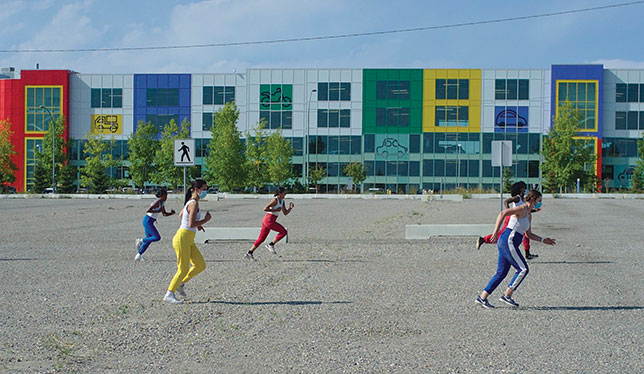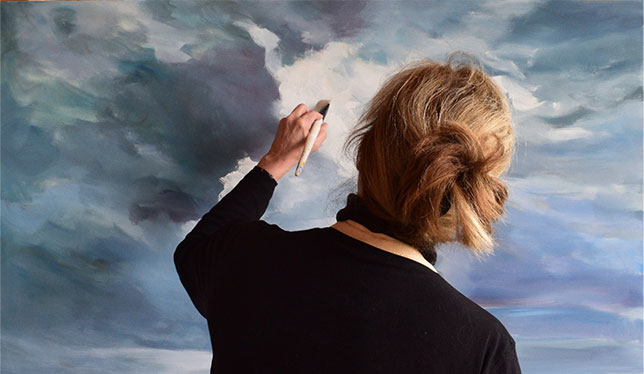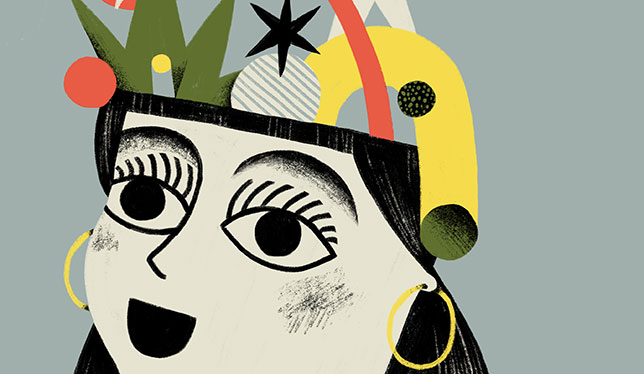In late November 2022, a few weeks before the launch event for his new book on creativity, David Gauntlett felt a mixture of excitement and fear about the upcoming gathering. Dr. Gauntlett, the Canada Research Chair in creative innovation and leadership at Toronto Metropolitan University, had promised in the event’s promotional material to perform some of his electronic music compositions.
During the COVID-19 pandemic, he had moved from what he calls “mere tinkering” to “releasing actual music.” But performing it in front of an audience was not yet in his wheelhouse. “I’m deliberately setting myself a challenge, which is uncomfortable and difficult, because that makes it more interesting,” he explains.
In Dr. Gauntlett’s view, creativity is not a superpower only special people get; creativity is simply a thing that people do. And for him, the launch for his book, Creativity: Seven Keys to Unlock Your Creative Self, was another opportunity to do something creative – in this case, perform new music that he developed during the pandemic.
The crisis of the pandemic necessitated imagination and innovation in many fields, from health care to education. Cities reallocated space to accommodate physical distancing, while businesses quickly pivoted to meet demand in previously unfamiliar areas, from personal protective equipment to hand sanitizer. Many people, meanwhile, picked up pandemic pastimes like baking or gardening, seeking creative outlets during an uncertain time.
But when it’s your job to be creative and innovative, as academics are often called to be, was the pandemic a boon or a curse? Did COVID kill people’s creativity or amplify it? Conversations with people who teach and research creativity reveal a time of both challenge and growth. Their reflections also capture what creativity is and why it matters as society looks to move beyond the pandemic.
An opportunity for reflection, repurposing
Dr. Gauntlett started writing his book in 2019. Then, along came the global pandemic. Many adults found themselves overwhelmed with multiple responsibilities at home and work, and research has shown that many academics – especially parents of young children – experienced a drop in productivity. But Dr. Gauntlett did not.
Even though he was juggling child care and work responsibilities, he began to find opportunities to do things he otherwise wouldn’t have done – a reaction he’s seen consistently in his research project, Reframing Creativity. The project looks at how creative practitioners, including artists, musicians, designers and stand-up comedians, responded and adapted in the COVID-19 pandemic, and what lessons can be learned from them.
For Dr. Gauntlett, the act of doing something different – in his case, making music – was a way to take his mind off what was going on globally while simultaneously engaging with the world by bringing something new into it. “One of the best things about creativity, in general, for everybody, is that sense of creating something where previously there was not a thing,” Dr. Gauntlett says.
The Reframing Creativity project also revealed that the pandemic and its abrupt changes to daily life jolted creatives into a different kind of headspace. Many of them considered what they wanted to bring to the world and how they were spending their time. “Almost everyone in our study found [the pandemic] to be valuable for that reason – that opportunity to reflect and think about what they do and how they do it and what it means,” Dr. Gauntlett says.
Again and again, that reflection led people to repurpose their existing skills, like a comedian who started speaking to businesses and offering shows for virtual office parties, or portrait photographers who experimented with remote photo sessions over FaceTime and Zoom. “The most striking thing … is people’s ability to pivot,” Dr. Gauntlett says.
Rethinking creative spaces
For many people, including Melanie Kloetzel, the adaptations the pandemic initially required have proven to have lasted. Dr. Kloetzel is a professor of dance at the University of Calgary’s school of creative and performing arts and oversees her dance company kloetzel&co.
One of her dance courses moved outdoors early in the pandemic to be safer for students. The semester finished with a performance in an abandoned parking lot. “It was a wonderful experience, for both me and for the students, to remind us that a theatre is not the only place where a performance can happen,” Dr. Kloetzel says.

University of Calgary to find new, safe performance spaces. They wound up creating a site-specific show in an abandoned lot. Photo by Brooks Peterson.
She has continued to look beyond the theatre as a space of creativity, to outdoor and online spaces instead. An art collective she’s part of, for example, moved online during the pandemic. The change allowed TRAction, which focuses on addressing issues of climate justice, to reach a national audience through new projects like an online mapping resource and a social media series on ways to fix the planet.
When Dr. Kloetzel returned to the theatre for a dance performance in January 2023, it was the first time she had been back since March 2020. But she’ll continue to treat the space differently, as with her latest show where the audience is taken on an immersive tour of the theatre.
“The theatre is this space of control, in a way. You get to control where an audience looks, how they’re seated, all of that. The thing about being on site, and also in social media spaces, is there’s a lot of unknowns,” she says. “That notion of giving up control a little bit is very enticing in a way, and it’s also scary.”
Creativity as a natural human capacity
In certain ways, creative people’s tendency to try new things and solve problems gave them cushioning for living through a global pandemic. “To be creative, you have to take risks. Maybe you try something and it doesn’t work out, but at least you’re willing to try,” says Mary Blatherwick, a professor of art education at the University of New Brunswick as well as a visual artist.
Dr. Blatherwick also researches creativity and is founder of the Atlantic Centre for Creativity. Previously, she helped launch the Canadian Network for Imagination and Creativity in 2020. Both organizations strive to promote interdisciplinary creativity across all fields as a tool for innovation and to address a variety of challenges.
The pandemic was an unusual and stressful time personally, but also a period of greater artistic production at a deeper level, Dr. Blatherwick recounts. She spent much of her time in Nova Scotia, where she helped care for two family members while still working full-time from an isolated winterized cottage. With plenty of hours to herself and sweeping views of the sea, sky and land, she worked on what became Limitless, an exhibition of sky paintings.
“For an artist, it’s a good thing sometimes to have that kind of quiet time,” she says. “As negative as [the pandemic] was, and it was terrible, I think it was also like pressing a reset button, to slow down and figure out what we’re doing and why we’re doing what we’re doing.”
“To be creative, you have to take risks. Maybe you try something and it doesn’t work out, but at least you’re willing to try.”
In Dr. Blatherwick’s view, creativity is a major capacity that society does not focus on, with most school systems emphasizing conformity instead. As a professor, Dr. Blatherwick says a large part of inspiring her students to make art involves dispelling the fear many people have of creativity.
“Everyone’s nervous they’re going to do something wrong,” she says. “I think we don’t recognize how creative we [all] are. We have an idea that you have to be Mozart or you have to be Leonardo da Vinci to be creative, but actually we do it all the time. [Creativity is] a human capacity that I think needs a bit more recognition on all levels.”

Creativity, at its core, is about bringing storytelling and problem-solving together, says Cheryl Thompson, assistant professor in performance at the creative school at TMU.
“Once you let go of the image that you have of the creative person, you actually start to become more creative because you realize that it’s not an identity, it’s not something that you put on. Every single person is a creative person,” Dr. Thompson says. “It’s just a matter of thinking about how to use your particular uniqueness when it comes to creativity to solve a particular problem that’s of interest to you.”
Dr. Thompson also runs a new research lab, The Laboratory for Black Creativity at TMU. In her view, the pandemic pushed creatives to understand that they have to be adaptable and able to pivot. “I think people realized that you have to start to think about how your skills are more transferable than maybe you thought they were,” she says.
Such broadening can help in other ways, too, as Dr. Thompson knows firsthand. She works to address structural issues in archives, specifically how Black people and histories are catalogued and identified through the Mapping Ontario’s Black Archives: Building An Inventory Through Storytelling project. Dr. Thompson says the aim of the project is to elucidate the diversity of the narratives, and how they connect across space and place.
By considering the perspectives of artists, archivists and researchers, Dr. Thompson brings an expansive view to the project. “It’s actually a very creative project, because it’s solving a problem but doing it in a very unique way that probably an archivist wouldn’t be able to do, and an artist wouldn’t be able to do,” she says.
Creating communities
Throughout the pandemic, some people discovered creative outlets were a helpful way to process their unfamiliar circumstances and feelings. Marianne Cloutier, who coordinates the activities of the McConnell-Université de Montréal Research-Creation Chair on the Reappropriation of Maternity, helped organize “La grossesse en confinement,” a project that asked pregnant people across Quebec to share a drawing, collage, painting or other handmade creation that reflected their experiences of motherhood during the pandemic. Participants shared photos of their work in a private Facebook group, and the pieces are also being turned into a book.
“There were some very beautiful creations that emerged,” says Dr. Cloutier, adding that the project also became “a community of support” for the participants. “They were talking to each other, realizing, ‘I’m living the same thing,’ saying, ‘I’m so glad you shared that.’”
As new communities sprouted, many existing ones were also uprooted. Getting cut o” from his in-person academic community in March 2020 was a big shock for Pramodh Senarath Yapa, a PhD candidate studying theoretical condensed matter physics at the University of Alberta. Weekly colloquiums, office drop-ins and a long-standing weekly karaoke date with professors and grad students suddenly stopped.
“For an artist, it’s a good thing sometimes to have that kind of quiet time. As negative as [the pandemic] was, and it was terrible, I think it was also like pressing a reset button, to slow down and figure out what we’re doing and why we’re doing what we’re doing.”
“We have this popular image of theoretical physicists sitting in their basement in front of a blackboard and just writing down equations. And, you know, sometimes that happens,” says Mr. Senarath Yapa, “but what really spurs that is the connection to community, talking to people, and then having this alone time to flesh out ideas in detail.”
He is no stranger to creativity, having won the Dance Your PhD competition in 2018. His thesis was a mini-musical about superconductivity, told through the medium of swing dance. That opportunity exposed him to a rich history of physicists melding scientific concepts with art. “Creativity is at the root of doing a lot of things in science,” he says.
While the pandemic brought plenty of time alone, he quickly realized “there were a lot of creative solutions to figuring out how to get back this connection to other people that’s very important to doing research.”
Among those was helping to move an in-person physics conference in 2020 onto Virbela, an immersive, “virtual world” in what’s known as the Metaverse. Mr. Senarath Yapa also connected with a friend and colleague in an unusual way; the two explained their research to each other through the medium of hip hop. Their video performance later won second place in a quantum-themed art competition. “It was this really strange time where people were open to trying very new things, just to fill in those gaps of community,” he says.
A fresh sense of discovery
In February 2020, Laura Loewen and a colleague held Canada’s first-ever collaborative piano conference. A few weeks later, lockdowns arrived. Like other performers, she found herself mourning a world that didn’t exist anymore. “All of the [conference] talks were ultimately about the power of music as a response to trauma. And it was so interesting, because what we were talking about then, we all desperately needed two weeks later, when the world shut down,” she says.
Dr. Loewen describes the pandemic as an exhausting time, but also an intensely creative time. She became the University of Manitoba’s Desautels Faculty of Music’s associate dean for undergraduate programs, in addition to her work as an associate professor of collaborative piano and as a vocal coach. The pandemic led to the longest break she’s taken from practicing piano since she started playing at age three.
“I didn’t practice a lot, especially the first year, because I was so busy being an administrator, and there was nothing really to practice for,” she says. When she started playing again, after about nine months, she was scared that she had lost her skills or wouldn’t enjoy making music. That turned out not to be the case. Her virtuosity remained, combined with the eagerness to play: “I had this discovery and curiosity that I just kind of lost along the way, without realizing it. So that was incredible,” she says. Like other people, she found the pandemic offered a rare chance to breathe, to look around, to realize that the prior hustle, busyness and stresses of life weren’t sustainable.
In that open space, people had an unprecedented opportunity to behold the power of imagination. Behind the pandemic’s countless challenges, this rekindling of creativity stands out. And we’re collectively left changed because of it – as we listen to electronic music compositions, partake in immersive dance performances, view expansive paintings, connect with each other differently and see long-standing problems solved in novel ways. Dr. Loewen has gone on to witness what she describes as a rawness to the music people are making these days – including her colleagues, her students and herself – following the experience of living through the pandemic and all of its trauma. The depths people are willing to explore in their music-making is unlike anything she’s previously seen: “I feel like everybody’s heart was broken open in COVID, and everybody makes more beautiful music than they did before,” she says.

Covid did not kill creativity. What kills creativity is not applying EDI as it should be in all academic aspects starting from the hiring procedure all the way to providing research grants, and providing equitable opportunities for all to fulfill their goals in career and life.
Covid is innocent. It is a hanger.